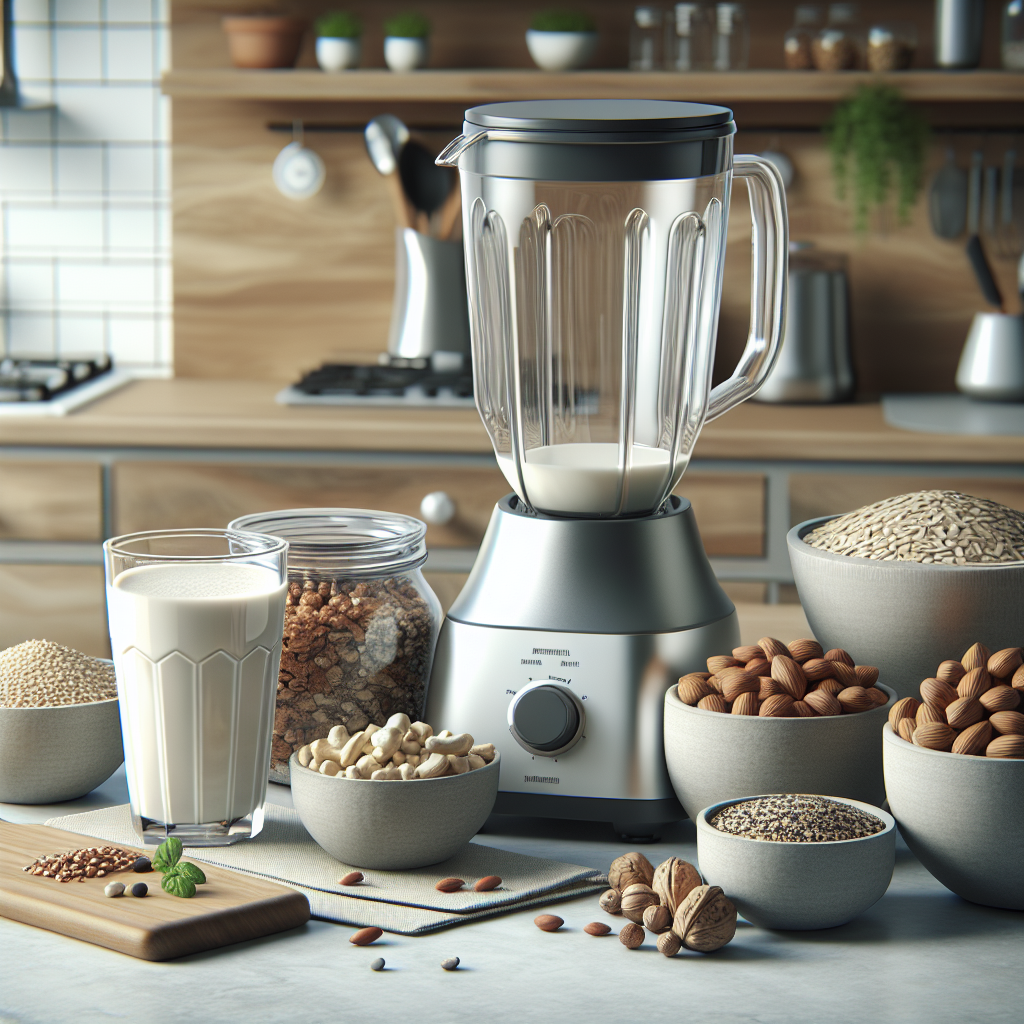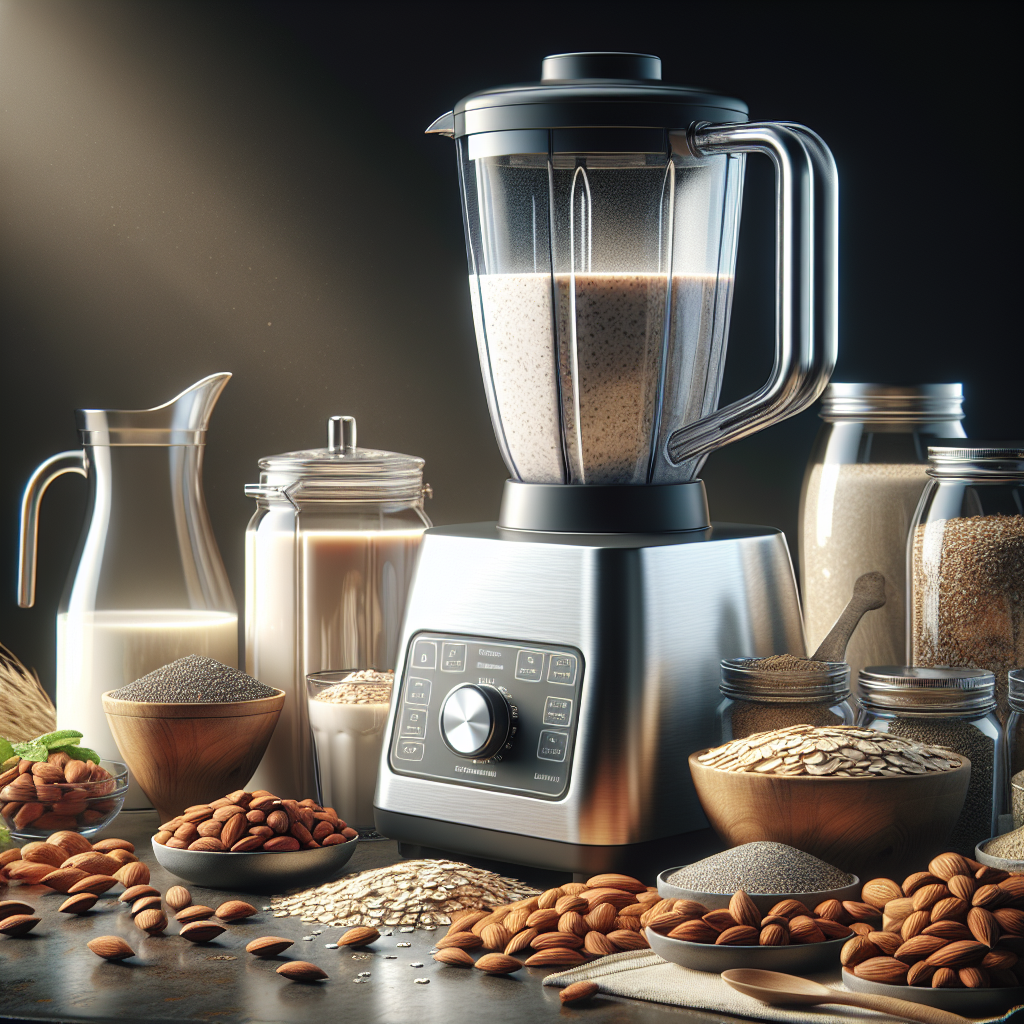In today's health-conscious world, many people are turning to homemade milk due to its numerous benefits. Unlike store-bought options, homemade milk is free from lactose, additives, and preservatives, making it a healthier choice for you and your family. Whether you are lactose intolerant, vegan, or simply looking to reduce your intake of processed foods, homemade milk offers a versatile and nutritious alternative.
One of the major advantages of making milk at home is the ability to control the ingredients. You can use a variety of nuts, grains, or seeds to create your milk, allowing for unlimited flavor options that cater to your taste preferences and dietary needs. Additionally, homemade milk is significantly more cost-effective, saving you up to 90% compared to purchasing store-bought varieties.
Moreover, making your own milk is an eco-friendly choice. By reducing the need for packaged products, you can decrease your environmental footprint. The high-quality stainless steel and powerful motor of the blender from MilkDepot.ca ensure that you get the best results every time, with minimal effort.
If you're ready to take control of your milk consumption and enjoy fresher, healthier options, get yours today! Start enjoying the myriad benefits of homemade milk with a blender that is both efficient and stylish, perfectly fitting into any kitchen decor.
Health Benefits of Homemade Milk

One of the most compelling reasons to switch to homemade milk is the array of health benefits it offers. Unlike commercial milk products, homemade milk does not contain any lactose, additives, or preservatives. This makes it an ideal option for those who are lactose intolerant or have allergies to certain additives commonly found in store-bought milk.
Homemade milk is also rich in essential nutrients. Depending on the base ingredient—whether it's nuts, grains, or seeds—you can obtain a variety of vitamins and minerals. For example, almond milk is high in vitamin E, a potent antioxidant, while oat milk offers a good amount of dietary fiber, which aids in digestion and promotes a healthy gut.
Another significant advantage is that homemade milk allows for complete control over sugar levels. Commercial milk products often contain added sugars, which can contribute to various health issues such as obesity and diabetes. By making your own milk, you can adjust the sweetness to your liking, using natural sweeteners like dates or honey if desired.
Furthermore, homemade milk is often easier to digest. The absence of harsh chemicals and preservatives means that your body can process it more naturally, reducing the likelihood of digestive discomfort. This is particularly beneficial for children and individuals with sensitive stomachs.
In essence, homemade milk provides a nutritious, customizable, and digestible alternative to commercial milk products. By opting for homemade milk, you are making a choice that benefits both your health and overall well-being.
Economic Advantages of Homemade Milk
Beyond the health benefits, homemade milk offers significant economic advantages that can make a substantial difference in your household budget. One of the most striking benefits is the cost savings. Making milk at home can save you up to 90% of the cost compared to purchasing store-bought milk. Given the rising prices of dairy and non-dairy milk alternatives, this can translate into considerable savings over time.
When you make your own milk, you only need to purchase the raw ingredients—such as nuts, grains, or seeds—which are generally cheaper and can be bought in bulk. This not only reduces the cost per serving but also minimizes the frequency of your grocery shopping trips. Moreover, the ingredients used for homemade milk often have a longer shelf life compared to pre-packaged milk, which means less waste and more value for your money.
Another economic advantage is the reduction in packaging waste. Store-bought milk often comes in cartons or plastic bottles that contribute to environmental waste and can incur additional disposal costs. By making your own milk, you significantly reduce the amount of packaging that ends up in landfills, contributing to a more sustainable and eco-friendly lifestyle.
Additionally, investing in a high-quality milk-making blender, like the one offered by MilkDepot.ca, ensures durability and long-term use. The initial investment quickly pays off as you continue to reap the benefits of homemade milk over the years. The powerful motor and high-quality stainless steel construction mean fewer replacements and repairs, further adding to your savings.
In summary, the economic benefits of homemade milk extend beyond mere cost savings. They encompass reduced waste, less frequent shopping trips, and long-term investment in durable kitchen equipment, making homemade milk a financially savvy choice for any household.
Eco-Friendly Aspects of Homemade Milk

One of the most compelling reasons to switch to homemade milk is its significant eco-friendly advantages. The environmental impact of commercial dairy and non-dairy milk production is substantial, involving extensive use of water, energy, and packaging materials. By making your own milk at home, you can contribute to a more sustainable planet in several key ways.
First and foremost, homemade milk drastically reduces packaging waste. Store-bought milk typically comes in plastic bottles or cartons, which contribute to landfill waste and take years to decompose. Making milk at home eliminates the need for these single-use containers, thereby reducing your household's carbon footprint. This shift is especially crucial in today’s world, where reducing plastic waste has become a global priority.
Additionally, producing your own milk at home cuts down on the transportation emissions associated with commercial milk. Store-bought milk often travels long distances from production facilities to grocery stores, consuming fossil fuels and releasing greenhouse gases along the way. By sourcing local ingredients and making milk at home, you minimize the environmental impact caused by transportation.
Water usage is another critical factor. The production of commercial dairy milk is notoriously water-intensive. For example, it takes approximately 1,000 gallons of water to produce just one gallon of cow’s milk. On the other hand, homemade milk made from nuts, grains, or seeds requires significantly less water, making it a much more sustainable choice.
Furthermore, homemade milk supports ethical sourcing and reduces the demand for mass-produced dairy and non-dairy alternatives that may involve questionable farming practices. By choosing to make your own milk, you can opt for organic and fair-trade raw ingredients, thereby promoting more humane and sustainable agricultural practices.
In conclusion, the eco-friendly benefits of homemade milk are multi-faceted. From reducing packaging waste and transportation emissions to conserving water and supporting ethical sourcing, homemade milk is an environmentally responsible choice that aligns with a sustainable lifestyle.
How to Make Homemade Milk

Making homemade milk is not only eco-friendly but also incredibly simple and rewarding. With the right tools and ingredients, you can create delicious, fresh milk in the comfort of your own kitchen in less than 60 seconds. Here’s a step-by-step guide to get you started.
Step 1: Choose Your Base Ingredient
Select your preferred base ingredient: nuts (like almonds or cashews), grains (such as oats or rice), or seeds (like hemp or sunflower). Each offers unique flavors and nutritional benefits, so feel free to experiment to find your favorite.
Step 2: Measure Your Ingredients
For a standard serving, measure out one cup of your chosen base ingredient. If you’re using nuts or seeds, it’s a good idea to soak them in water for a few hours or overnight. This softens them and makes the blending process smoother.
Step 3: Add Water
Combine your soaked (or unsoaked) ingredients with four cups of filtered water in your MilkDepot.ca milk-making blender. This 1:4 ratio generally provides a balanced, creamy consistency.
Step 4: Blend
Secure the lid on your blender and select the milk-making setting. Thanks to the powerful motor and built-in filtration system of the MilkDepot.ca blender, your ingredients will be transformed into smooth, creamy milk in less than 60 seconds.
Step 5: Strain (if necessary)
If you prefer an ultra-smooth texture, you can strain the milk through a fine mesh strainer or nut milk bag. However, with the MilkDepot.ca blender’s advanced filtration system, this step is unnecessary.
Step 6: Flavor Your Milk
This is where you can get creative! Add a natural sweetener like honey or maple syrup, a pinch of salt, or even a splash of vanilla extract. For chocolate milk, mix in some cocoa powder. The possibilities are endless!
Step 7: Store and Enjoy
Pour your homemade milk into a glass bottle or jar and store it in the refrigerator. Fresh homemade milk typically lasts for 3-5 days. Shake well before each use, as natural separation may occur.
By following these simple steps, you can enjoy the numerous benefits of homemade milk—freshness, flavor, and eco-friendliness—while also having complete control over what goes into your beverage.
Tips for Flavoring Homemade Milk

One of the most delightful aspects of making homemade milk is the ability to create a variety of flavors tailored to your taste buds. Unlike store-bought options, homemade milk allows you to avoid artificial additives and sweeteners while exploring endless flavor possibilities. Here are some tips to help you flavor your homemade milk like a pro:
Sweeteners
Natural sweeteners can enhance the taste of your milk without adding unhealthy sugars. Consider using honey, agave nectar, maple syrup, or even dates. Simply blend these with your milk until fully dissolved to achieve a balanced sweetness.
Spices and Extracts
Spices and extracts can add a unique twist to your homemade milk. Vanilla extract is a classic choice, but don’t hesitate to try almond extract, cinnamon, nutmeg, or even a hint of cardamom. Add these ingredients in small amounts and adjust to taste.
Fruits
Fresh or dried fruits can infuse your milk with natural flavors and nutrients. Berries, bananas, and mangoes are popular choices. Blend the fruits with your milk and strain if needed for a smoother texture. For a tropical touch, try adding a small amount of coconut milk or shredded coconut.
Chocolate and Coffee
If you’re a fan of chocolate or coffee-flavored beverages, you’re in for a treat. Add cocoa powder or brewed coffee to your milk for a rich, indulgent drink. For a mocha flavor, combine both cocoa and coffee. Adjust the quantities based on your preference for sweetness and intensity.
Healthy Add-ins
Boost the nutritional value of your homemade milk by adding superfoods like chia seeds, flaxseeds, or matcha powder. These ingredients not only enhance the flavor but also provide additional health benefits.
Experimenting with different flavors can turn your homemade milk into a versatile beverage that suits any occasion. Whether you prefer it sweet, spicy, fruity, or rich, the possibilities are endless, and you have complete control over every ingredient.
Ready to start making your own flavored milk at home? Get yours today! and explore the delightful world of homemade milk with MilkDepot.ca.
